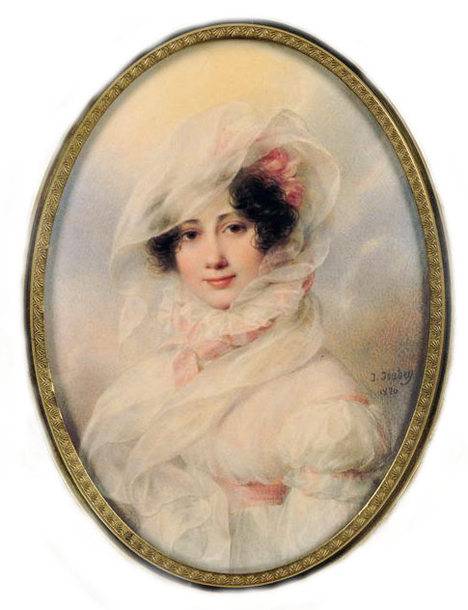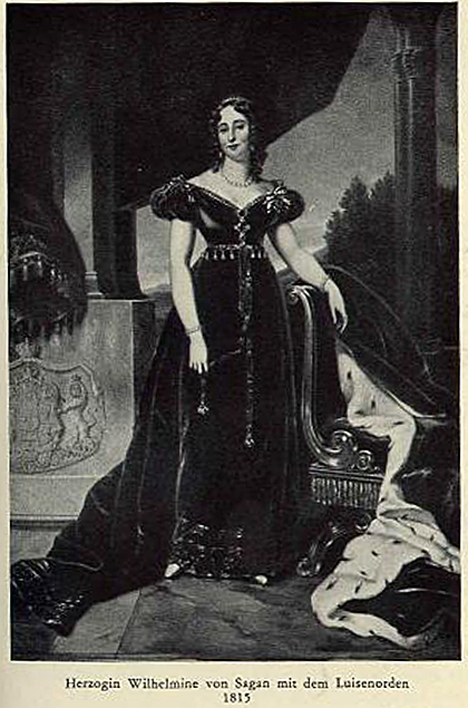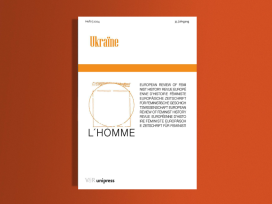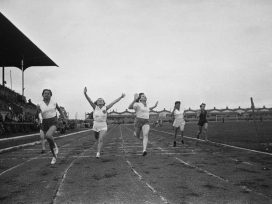The Congress of Vienna, which ran from September 1814 to June 1815 and was to settle the terms of a post-Napoleonic world order, lies at the heart of a historical narrative of the modern transformation of European politics, as the threshold of new forms of international political cooperation and coordination undertaken in the interests of peace, and sometimes referred to as the “Concert of Europe”. On this view, the Congress was the moment when the foreign ministers of Britain, Austria, Prussia and Russia elaborated a system of shared diplomatic procedures and norms of international political conferencing and invoked ideals of a distinctively European and Christian civilisation, joined in their ambitions for peace.
As significantly, even if rarely noticed, the Congress of Vienna coincided with changing norms of gender relations, specifically in practices of international politics and diplomacy. In the 1960s, the Austrian historian of the Congress of Vienna Hilde Spiel noted “Never before – or after – have a group of statesmen and politicians, assembled solely and exclusively to deal with matters of commonweal interest, labored so extensively and decisively under the influence of women – not in Munster, nor in Rastatt, not in Versailles, nor yet in San Francisco”. Yet political histories of the Congress have continued to ignore these women, or pushed them to the margins of more historical and popular accountings of “the Congress that danced”, where they appear as whores or mistresses, the double agents of imperial and national conspirators. To be sure, these historical depictions resonate the ambiguities that surrounded women’s presence even in 1814, including the view of women’s intervention in matters of international politics as characteristic of outdated untransparent diplomatic practices. In this essay I want to argue that the unreflective and limited historical reproduction of representations of women as the markers of the moral foibles of a dissolute and disappearing aristocratic and pre-modern European order provide the most basic evidence of the gender dimensions of the Congress as a political Zeitenschwelle.

Miniature portrait, likely of Princess Bagration by Jean-Baptiste Isabey, 1820. Source:Wikipedia
Given what we already know about the political history of women and gender in late eighteenth and early nineteenth century western Europe, and about the early modern history of diplomacy, we should not be surprised that – even beyond the Enlightenment and French Revolution – women and gender are relevant to the international history of the Napoleonic wars and the processes of peacemaking that followed. Existing gender histories suggest that aristocratic and noble women were long involved in matters of diplomacy. They used their family (often dynastic) and personal connections, wrote letters, and ran salons to diplomatic ends. A relevant example for the purposes of this essay comes in the form of the critical political role played in international history by the Paris-born and independently wealthy Germaine de Staël (or Madame de Staël), famous since the 1790s throughout Europe and Britain for her novels and cultural writings, and her Paris and Coppet salons. In the context of the great political upheavals of this period in France, Staël maximised the political advantages of her arranged marriage, which gave her status as both a Baroness and a Swedish ambassadrice. As I have argued elsewhere, adding Staël also directly links the salon as a forum of political negotiation with the newly formalised practices of diplomacy itself.
From mid-1812 onwards, having fled Napoleon’s increasingly repressive censorship of herself and her friends, Staël drew on her exceptional cultural and political standing and utilised familiar conventional diplomatic tools – networks, letters, her salon, and her published writings – to rouse opposition to Napoleon among European statesmen and sovereigns. Present in St. Petersburg and Stockholm in the crucial period of Coalition formation, Staël worked hard to encourage and build links between the Russian Tsar Alexander and Swedish Crown Prince (and former French Marshal) Bernadotte. Her aim was not only to defeat Napoleon, but to influence a liberal post-Napoleonic European order. She continued her salon activities in London in 1813 and then, after Napoleon’s defeat, in Paris from May 1814. Even though Staël did not attend the Congress in Vienna, her salon operated during the crucial weeks of peace treaty negotiations that established the template for the Congress itself, including its liberal pretensions and its inclusion of abolition as an international concern.
Staël is a measure of how, despite her fame and reputation at the time, recovering the agency and influence of women is only possible when historians make the self-conscious decision to add women. She provides a useful backstory to the argument that if historians are to challenge the prevalence of unanalysed gender stereotypes and gender segregation that have shaped historical narratives of the Congress, they need to begin by recovering women’s presence in the past, before acknowledging their absence. Indeed, although Staël’s salon activities before and after the Paris Peace Treaty are not considered in international histories of the campaign against Napoleon, or the lead-up to the Congress, they establish the continuing importance of female political agency in this period, as well as the changing ambiguities and controversies surrounding women’s agency.
In this essay, I pursue this argument further by focusing on the presence at the Congress of two aristocratic salonnières from the Russian Empire, Princess Katharina Bagration and Wilhelmina Duchess of Sagan, and the young Genevan ingenue Anna Lullin-Eynard, niece of the patrician Genevan ambassador Charles Pictet de Rochemont and wife of the wealthy self-made financier Jean-Gabriel Eynard. Each of them has either left us a record of their investment in the Congress, or can be tracked through the archival documents, particularly the secret police reports that have provided so many historians of the Congress with a seductive key to the private dimensions of diplomacy. As we will see, adding these women to the history of the Congress goes some way to reconnecting the history of ‘dansomania’ with the history of diplomatic parleying that took place in ballrooms as much as rooms of state, where statesmen and supplicants gathered at the rooms of the female leaders of Viennese society, and men and women engaged the pressing politics at stake in 1814.
Intriguing Noblewomen? The Princess Bagration and the Duchess of Sagan
Should we care about the Duchess of Sagan or Princess Bagration and their motives or their influence at the Congress? That these aristocratic women from the Russian empire were of particular interest to the Austrian secret police, or that historians often use them to exemplify the ‘intriguing’ women who exerted influence over Congress statesmen, can be attributed to a historical appetite for the salacious story. The difficulty of assessing their place in the political history of the Congress has not been helped by the fascination with their beauty and behaviour or their shared and intersecting pasts: Sagan and Bagration lived next door to each other in the Palais Palm on Vienna’s Schenkenstraße (only a short distance from the Austrian Chancellery), they both had affairs with the Austrian Foreign Minister Clemens Metternich, and both sought personal, financial and political favours of the Russian Tsar Alexander. Some Austrian police reports claimed both women were on Russia’s payroll and accepted their tasks in order to make ends meet, or in order to avenge themselves against Metternich. All of which, other spies argued, explained Metternich’s own policy failures in regard to Russia, and the Tsar’s persistence with a liberal, and pro-Prussian agenda. Early in the formal proceedings of the Vienna Congress, one ubiquitous informer could not resist reporting to Baron Francois Hager, the President of the Oberste Polizei und Censur Hofstelle, that it was not the first time that the intrigues of women had influenced the politics of States, and men were to blame.
Adding Sagan and Bagration to the events leading up to and during the Congress of Vienna helps us see beyond a dancing congress, even when sex was implicit in the game of power. The characteristics of their political involvement draws our attention to the continuities in the history of diplomacy and the shifting gendered social register in the parsing of politics and power in a new age of international relations. Their stories offer an important contextualisation for how we might read the “you” in Metternich’s written reproof to his lover Wilhelmina in 1813 as she took her first taste of involvement in the diplomatic dimensions of the struggle against Napoleon – “The past, my friend, is not you!, This past is the domain of history”. For all the ambiguity of Metternich’s use of the pronoun “you”, it points to Sagan’s presence in international political life, and the ideological work taking place, that is the delimitation of the roles of women who wielded cultural or economic power, and their elision from history.
Despite the tenor of secret police portraits of Bagration and Sagan, the two rivals were not naïve young women. They were at the time of the conference 33 and 35 years old respectively, although farther apart in terms of their aristocratic status. Bagration was born Catherine Pawlovna Skavronska. Her father had been a Russian minister in Naples, her stepfather was the grand master of the Russian Court, so she knew the life of diplomacy and politics too. At age 17 she had married Prince Pierre Bagration, a much older Russian general, on the order of the Russian Emperor, Paul I, Tsar Alexander’s father. By 1814, she was a widow. Before then, the twenty years that divided their ages, and Prince Bagration’s absences, had driven his young wife to a life of determined independence, usually in Vienna or Carlsbad.
If Bagration diminished her social status through what today we would call her ‘lifestyle’, as a great niece of Catherine II and Prince Potemkin, she had status to spare. Like many beautiful aristocratic women of her time, history would record her simply as “the naked angel”, remembered for her capacity to wreak havoc with men’s hearts. As importantly for our purposes, Bagration was occasionally referred to as “one of those diplomatic sibyls whose mission was to gain friends abroad for Russia’s political aims.” Several years earlier, the Baltic-German Charles de Nesselrode wrote his father (also a Russian empire diplomat) that of the many Russians in Vienna, he most often visited the amiable princess Bagration, whose house was the most lively. There he would meet members of the local diplomatic circles, as well as the ‘second class’ of local Jewish bankers. It was also around this time that Bagration may have begun her affair with Metternich, which ended with her giving birth to his illegitimate child.

Duchess Wilhelmine von Sagan, 1815. Source:Wikipedia
Wilhelmina was one of four daughters of the Duke of Courland and Countess Anne-Charlotte Dorothée de Medem. The Courlands represented the aristocracy of the Baltic (now Latvian) provinces “whose ethnically German landowners still owned large peaks and staged English-style hunts and who lived on their estates all the year round, and operated according to feudal law”. When the Duke was forced to sell the Courland estates to the Russian court, he purchased the Duchy of Sagan, near Prague, a terrain that had belonged at various times either to Saxony, Habsburg Bohemia, or Prussian Silesia. In 1800, with the Duke’s death, the land became the eldest daughter’s responsibility, thanks to the still labile inheritance laws in this part of Europe. Wilhelmina’s preferred residence in the Duchy was Ratiborschitz, which she had transformed into an Empire-style castle with an English garden. Her more familiar domains however were the courtly circles of the Prussian capital Berlin where she had been raised but for which she had no affection, and Vienna where she kept apartments. The Duchess, like her sisters, was also the beneficiary of that rare thing for girls, an excellent education. On that basis and her polylingualism (which included the local dialect from Sagan), she became a bibliophile, a keen collector and reader of books. Nor did she lack for female role models. Her mother had managed the family estates and had diplomatic experience of her own, having been sent by Grand Duke Peter as special ambassadress to Warsaw. Motivated by France’s part in the collapsing economy of the Russian empire – which affected the family’s income – Anna-Dorothea was drawn into Talleyrand’s sphere of influence, as he sold secrets to the Austrians and Russians and took over her correspondence with the Tsar as a means of evading French surveillance.
Like her mother, the Duchess personally administered Sagan. She was as consumed by current affairs and au fait with the complex history and politics of Central Europe. She knew most of the statesmen of the region, and gleaned political information through her vast network of family and friends. One biographer claims that when in 1809, in her absence, her castle was laid siege to by Napoleon’s forces, she made her estate available to the Duke of Brunswick and the resistance group Death’s Head Hussars for their fight against French occupation and on Austria’s side. When Napoleon then threatened to confiscate her duchy in retaliation, Sagan conscripted and outfitted 500 men to defend the property. We know too that the Courland women were members of the anti-Bonapartist Lodge of Roman Ladies, despite Wilhelmina’s youngest sister Dorothea’s employment as lady in waiting to Napoleon’s second wife Marie Louise. Sagan’s own correspondence suggests that (unlike Staël, whom she knew) her defiance of Napoleon was driven by francophobe anti-revolutionary conservatism. As she told Metternich, “My God, how I hate and abhor all liberal ideas”.
In the dizzying days of alliance building in opposition to Napoleon, Ratiborschitz was co-opted as the site of informal discussions between the courting coalition partners. The 1813 meetings palpably marked a new era in Sagan’s life, as she was inducted into the possibilities of salon diplomacy. All the latest news in negotiations passed through this Central European outpost under Sagan’s charge. Nesselrode, who by this time was a key member of the Russian diplomatic corps, would recall that the Ratiborschitz conference was one of the most stormy to which he had been witness. At issue were differences over an armistice, giving in to Napoleon or fighting him, and ultimately the rallying of Austria as an active partner of the Coalition and its agreement to fight on. Sagan was to exert her influence on the transition of Metternich’s policy for Austria, from political appeasement to military antagonism.
Although Metternich made much of the fact that Ratiborschitz had become the “centre of European diplomacy at the moment when this poor Europe is the foyer of the world’s troubles”, he would persist in writing to Sagan demanding that she forego being “political”. When she tried to draw his attention to the needs of the numbers of wounded and dying soldiers that crowded the streets of Prague in late 1813, Metternich was more concerned with pre-empting the extent of her involvement: “I expect at least to be obeyed in politics.” Desperate, Sagan justified her request on the imperative of “humanity”. Yet Metternich had little reason to fear the direction of Sagan’s politics, as she reiterated her sympathies with his own ideological preferences: She was faithful to the principles of her upbringing and detested the democratic associations that fed the values of self-love, vanity, insolence, unsociability, and the inability to achieve an eminent degree of ‘civilisation’. Republicans were so annoying she preferred slaves.
At the Vienna Congress, Sagan’s politics were broad enough to include sympathy for the resuscitation of Poland, and opposition to a Prussian-led German federation, in part because of the threat posed to her own sovereignty, in part because of her personal prejudice against Prussia, born of her ostracisation from the Prussian court. Again she preferred a return to the old order of things, a politics that identified social stability with “this stability that we seek in vain in the heart of man’s esprit.” These were the political ambitions that Sagan worked through her salon in 1814.
The significance of Bagration’s salon was noted in late September as the main actors in the Congress theatre began to arrive in Vienna, and Russian diplomats headed to the Palm Palais. She brought to her gatherings a longer-standing reputation of having influence over the young and old who gathered around her skirts and took up her anti-Napoleon views. Yet we know less about Bagration’s political inclinations over this same period. Spies in Vienna reported occasionally on the detail of her discussions with Alexander as she allegedly tried to talk him out of granting Poland independence and into giving the pro-Napoleonic Kingdom of Saxony to Prussia. Other sources state, as was more likely, that she supported Saxony not Prussia. The letters successfully intercepted by the Austrian secret police are replete with political commentary claiming that Bagration (like Sagan) hated the German federationist Baron vom Stein. Some evidence points to more complex dual-faced relations. Bagration constantly advised individuals who sought out the Tsar, even as she dismissed Alexander’s politics as ‘Jacobin’. The police reports tell us, too, that despite her fortune, by the time of the Congress she was in desperate need of money, having entertained lavishly at her apartments.
As the Congress dragged on, spies in the pay of the Austrian secret police concurred that Bagration and Sagan were both guilty of scandalous conduct, and their financial predicaments ruled their social and political efforts. They repeatedly alleged that these women were agents of Russia and Prussia who put their amorous intrigues at the service of their political intrigues. On some accounts their spymaster was now the Prussian delegate Wilhelm Humboldt. Once Wellington arrived in 1815, he, too, was associated with both women, as their protector. When Napoleon escaped from Elba in March, Bagration’s association with Napoleon’s stepson Eugène de Beauharnais suddenly saw her tainted a neo-Bonapartist.
As important for how we read these police reports and contradictory claims is the fact that they were filtered through the lens of a general prejudice against women’s political involvement. Exemplary of this prejudice were the views of the Danish Minister of Foreign Affairs, Baron Rosenkrantz, who recorded in his diary that the failures of the Congress were due to the number of occasions on which women were brought into individual confidences. He blamed the Russian Tsar for this tendency to confide in “des Dames” (Rosenkrantz protested that his opinion was not prejudicial since he was married to the Russian Princess Varvara Alexandrovna Viazemskaja). Worse still, from Rosenkrantz’s perspective, was the meddling of women themselves.
Anxieties about the influence exerted over men by specifically ‘independent’ women reflected the different expectations surrounding the behaviour and moeurs of cosmopolitan aristocrats, male and female, on the one hand, and a new middling or bourgeois class, on the other. When Sagan wrote from Vienna to Metternich – perhaps only playfully – that she wished she could live a bourgeois life of moderation removed from the excesses of le grand monde, she was reiterating the moral dimensions of an increasingly apparent cultural class divide. When the Genevan self-made financier Jean-Gabriel Eynard made his steady way on the eve of the Congress to Vienna as secretary to the Genevan delegation with his young wife Anna Lullin, he dreaded the corrupting influence of this same grand monde.
Eynard had met his wife in Geneva, through their common acquaintance with Staël. He was part of the Genevan delegation to Paris in May 1814, and attended Vienna in similar guises, as the representative of the Queen of Etruria, and as secretary for the Genevans. Anna Lullin had not gone to Paris, even though as Rochement’s niece, and despite her impoverished upbringing, she was familiar enough with the world of diplomacy and salons. If we are to believe their respective diaries, the Eynards did not expect she would have any role in the events that were to take place. However, Anna shared with her husband concern over the impending negotiations in Vienna to determine the political position of Geneva as a new canton in the Swiss Confederation, as well as its claims to inviolability, neutrality, and new territory – on Geneva’s French border, namely the Pays de Gex, and the Versoix corridor connecting Geneva to the rest of Switzerland.
The Eynards are a useful illustration of the ways in which, by 1814, the political and social landscape of Europe had been broadened enough to make space for individuals whose claim to notice was their money, or their talent for sociability. The rise of an ‘entrepreneurial’ class was a story common across East and West Europe, including the Habsburg empire. Among this class in Vienna, for example, were the Christian private bankers who also founded industrial enterprises, and court Jews, who were more restricted in the roles they could play, but provided crucial financing of government debt, and for the aristocracy themselves. As the Eynard diaries show, the Vienna conference brought this new bourgeois Habsburg world into contact with the established Genevan bourgeois class, and mingled both with the diplomatic networks built on aristocratic and noble relations, and, in the process, reconstituted the new class, gender, and national ranks in Europe. They also offer evidence of the changing expectations of bourgeois women in this setting, as ambassadrices of a new kind, assisting their husbands in the soft diplomacy that was to become a fundamental part of modern international politics.
The Innocent Genevan Bourgeois Lullin
Once established in the mixed circuits of Congress sociability, there were thresholds that the Eynards would not cross for reasons of morality, namely those of Bagration and Sagan. In all other ways, aristocratic balls, dinners, salons, soupers, punctuated the rhythms of the Eynard’s daily routines. Any one day their socializing might take them to a picque nique de la noblesse, attended by all the court, and then to a social event staged by fellow (albeit non-Christian) bankers, the Arnstein’s, where there was a predominantly Prussian presence. Lullin described Fanny and Nathan Arnstein as immensely rich Jews at whose residence one could meet each day of the week a very considerable circle of strangers, country people, ministers, and Princes. Fanny Arnstein had established a reputation as a significant salonnière and, as the secret police reports noted, she was active during the Congress on behalf of Prussia and Jews.
The theme of ‘mixing’ runs through Lullin’s memory, weaving a class-conscious cultural continuum out of her ad hoc experiences. She was as surprised as anyone that she had been feted and flattered, a young ‘small’ republican in the midst of dancing monarchs. She also marvelled at her own ability to engage monarchs and promote the cause of a united republican Switzerland, even as she disdained the collapse of barriers between royalty and commoners in the social whirl of parties and parades on the Vienna Prater. The King of Prussia promenaded in the middle of the crowd, where he was recognised and followed. At an evening ball Lord Castlereagh asked her to dance a polonaise, which she accepted all the while painfully aware that she was dancing in the midst of sovereigns, alongside Emperors, Kings, Princes, so close that she had to make an effort to ensure she did not touch them. When one extravagant souper saw the sovereigns served in a separate section at a table with sixty covers, the Tsar and King of Prussia moved around in order to be able to ‘court’ the Princesses, Duchesses, and Countesses. Soon she, too, was the object of the sovereigns’ attentions.
Dancing with sovereigns and statesmen encouraged Lullin to raise the topic of Switzerland and its virtues informally – even as the Swiss committee created to oversee statistical assessments of Swiss claims and comprising a number of Coalition delegates, took formal responsibility for resolving these same questions. When the Prussian king proclaimed his hope that all the partying and pleasure did not distract from important affairs, Lullin replied with the suggestion that “our small republic of Geneva” was among the concerns she hoped would not suffer. The King, according to her diary, responded that he knew it was among the questions with which they were busy. Similarly, she was able on a number of occasions to turn the conversation with the Tsar to “the Swiss” and their loyalty to the Coalition cause.
Lullin’s informal diplomacy was not all her idea. Getting the peacemakers on side was more or less handed over by the Genevan delegation to the two wives in tow. After arriving in Vienna, when the other (Ivernois’) wife fell ill, Lullin found it fell to her to show herself in public, meet important men, and report all she heard, as well as present Geneva’s territorial claims as an attractive cause. The Eynards also took it upon themselves to hold ‘salons’ of a kind for the diplomats to attend and talk about Geneva in an intimate setting. Their receptions were modest affairs and tended to the provision of tea with the occasional diner. The conversation would begin in a general fashion, and after tea informal chatting would take over between neighbours, men and women.
For the most, however, Lullin’s diplomacy was undertaken in other people’s settings. As the only woman invited to a diplomatic dinner by Talleyrand, it was her responsibility to fulfil her new role. Lullin took every opportunity to talk with the British delegates, whether Castlereagh, Canning, or Stewart, about “notre patrie”, its frontiers and the difficult situation of Geneva. On some Swiss accounts, it was Lullin who was able to swing the English over to the Genevan side, and in striking contrast with the failed competing efforts to represent the Swiss cause by Berne’s Louis Zeerleeder, a banker who, Genevan historians have claimed, lacked both diplomatic skills and a wife. The result was that Geneva emerged from the Congress with more territory than the other Swiss cantons. It received Versoix, parts of Pays de Gex, and further concessions in Savoy.
In the localised Swiss annals of Congress myth, Lullin’s exposure to the Congress, to flattery and seduction were her trials. She passed with flying colours establishing herself as impervious to its seductions, and a stalwart spokesperson for the bourgeois values of the family, and of Geneva itself. For our purposes, what is most significant about her involvement, is its revelation of the intermingled ambitions and agency, experiences and expectations that comprised contemporary diplomacy and international politics. Despite the Eynards’ expectation that they would be kept at a distance, the Congress was the beginning of their transformation from bourgeois couple into self-conscious cosmopolites, regulars on the new conferencing system trail, and best friends with the British Lord and Lady Castlereagh, who shared their views of Bagration and Sagan and of the supplementary role of wives in the realms of soft diplomacy. Indeed, the Eynards lead us across the threshold of a European society gendered on a British model, and in which, as Spiel noted, “ladies, would-be ladies, princesses, adventuresses, ladies of the high aristocracy, and emigrants from the lower nobility, who, to a body, having said farewell to the ancien regime, set about consciously to adapt themselves to bourgeois life and made their homes in it.”
The victory of bourgeois values is also apparent in the detail of Jean-Gabriel Eynard’s diary, which does not mention his wife’s role in his record of events, although they were completely central to Anna Lullin’s record of the period. Instead he noted his displeasure when the Tsar advised Anna to ask her husband to bring her shawl, a sensitivity to detail regarded by the Swiss bourgeois as beneath the emperor’s dignity. Husband and wife were equally embarrassed when the Tsar saluted them from his loge in the theatre of the Schönbrunn. They each commented in their respective diaries on the lack of dignity of these male monarchs. Lullin could not help but admire the King of Prussia’s modest air, but ultimately she condemned his modesty as ill-befitting a King. In Vienna, the monarchs mixed amongst the crowds, and danced with the common people, a form of exposure that, the Eynards concluded, stripped the kings and emperors of their vital mystery. Ultimately, as the invitations from aristocratic and noble circles came on thicker and faster the Eynards decided it was time to withdraw and return home to Geneva, where le grand monde would no longer distract them from the pursuit of productive work and responsibilities to their family and home.
Conclusion: Adding Women and Stirring
If there are lessons to be taken from this brief survey of only a few of the women involved in the Congress they are, most obviously: Women were fundamentally invested in the political events and questions of international peacemaking; and women were implicated in its diplomatic processes, even if not always in ways that determined the immediate political outcomes.
For our purposes, Bagration and Sagan illustrate the roles assumed by ‘independent’ wealthy aristocratic women in the early nineteenth century, often subsidising the men in their lives and seeking ways of exercising power or being meaningful players in the drama of politics. Their political conservatism can be linked to their concern for their personal interest, as well as ideological convictions. In this context, their morality, or sleeping habits are as relevant to international history as those of the men with whom they had relationships. Bagration, Sagan, and even Lullin offer evidence of the acknowledged contemporary importance of women as accomplished agents of the political sociability critical to international relations and diplomacy. They also suggest that the possible influence of independent aristocratic women, and their ‘lifestyles’, increasingly generated anxiety in ways that the supplementary hostessing and sociability of wives (whether bourgeois or aristocratic) did not. In this way, the history of the dancing congress confirms the findings of new national histories of diplomacy, which mark the early nineteenth century as a threshold for changing gender roles and relations.
At the same time, adding women to the story of the formation of the coalition that defeated Napoleon, and the formulation of a post-Napoleonic European order not only establishes the fact that ‘history’ has rendered women invisible, it highlights the relevance of women to the gendered history of international politics. In general, after the Vienna Congress there were fewer women involved in the conferencing that established the new terms of the Concert of Europe. In 1817, Frederick Lamb – an English diplomat and Sagan’s more serious object of amorous attentions during the Congress – wrote from Frankfurt, where the German confederation was under discussion, that the lack of women opening their homes had stymied negotiations. This observation coincided with the increasing (albeit slow) formalisation and professionalisation of diplomacy that gave concrete form to the ‘international’ as a space of inter-state negotiation, and with the intensification of state-building through national identification, a process which confirmed men as the stakeholders of modern political life. In the context of the peacemaking processes that established the post-Napoleonic world order, and of a gender Zeitenschwelle, this history illustrates, too, the simultaneous marginalisation of women’s individual or independent agency altogether. This marginalisation included the salonnière typified by Germaine de Staël, exercising her wit, genius, and conversational skills.
Salons continued to exist in the aftermath of the Congress, into the 1850s, including the London and Paris salons of Wilhelmina’s sister Dorothea (a prerogative allowed her as Talleyrand’s “companion”), and of the Russian ambassadrice Dorothea Lieven, who operated in diplomatic circles and focused on British, French and Russian foreign policy. These were singular female figures, and despite their obvious intellectual power and influence, their agency was often controversial, and accepted only in so long as they were attached to an important male figure.
Recovering women’s place in the history of the campaign against Napoleon resuscitates old questions about the invisibility of women in the larger history of the remaking of Europe in the early nineteenth century. In part, we might place the burden of that historical invisibility on the fact that women mostly did not act as the formal representative of states, and the historiographical practices that developed in the nineteenth century were framed by narratives of state-building. In that context, recuperating women’s presence is partly a case of restoring non-state actors to the story of international politics. However, it is as obvious that modern historians have repeatedly found it simpler to forget women, or slight them in favour of male, often less able, non-state actors. Indeed, the absence of women from the story of the transformation of European politics, and the ‘revolution’ in international politics mirrors a more general and continuing effacement of women from political and intellectual history. The motives may no longer be moralistic, but the resonances of nineteenth century gender-selective bourgeois moralism certainly have lingered when historians have been ready to acknowledge women’s presence at “the Congress that danced”.








